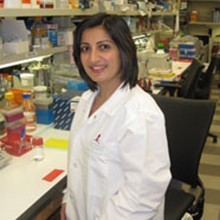Spotlight
Nidal Boulos
July 2012

The CERN Foundation’s primary focus continues to be finding the best treatment and eventual cure for ependymoma in both pediatric and adult populations diagnosed with this disease. We had the opportunity to speak with Nidal Boulos, Ph.D., one of the lead researchers funded by the CERN Foundation at St. Jude Children’s Research Hospital to hear about some of the team’s accomplishments in developmental therapeutics.
Originally from Lebanon with a Bachelors of Science in Medical Biology, and a Masters Degree and Ph.D. in Pediatric Oncology, Nidal graduated in 2004 and began her post doctorate studies at St. Jude Children’s Research Hospital in pediatric Leukemia.
In September 2010, Nidal joined the CERN Foundation’s pediatric research team led by Dr. Richard Gilbertson, a Member of the Department of Developmental Neurobiology and Oncology and the CERN Foundation’s co-principal investigator, to help further our efforts in developmental therapeutics.
When we asked Nidal about her experience thus far in the lab she replied, “We are at a very exciting stage as we continue our progress in modeling the different subtypes of ependymoma. We have an excellent and enthusiastic team in place, both basic scientists and clinicians that work very closely together in ensuring the identification of active agents and their progress into clinical trials to the benefit of patients.”
Currently, we are aware of nine different subtypes of ependymoma in the pediatric population that are biologically distinct. Understanding the biology of ependymal tumors is extremely important for treatment of patients. The researchers at St. Jude have created a preclinical model that recapitulates one subtype of ependymoma and have used this model to identify drugs that are selectively active. Nidal and her colleagues are very excited to have seen significant responses generated from a couple of FDA approved drugs against their model. They are now hopeful in their ability to take these results and move forward into clinical evaluation for patients that have not responded to current therapies. The use of FDA approved drugs in their screening efforts also helps to speed up the process of bringing new treatment options to the clinic. In addition to this, the screening of new chemical entities (such as natural products) has the potential to allow identification of entirely new drugs for the treatment of ependymoma.
The CERN Foundation’s team at St. Jude will continue their research efforts to model the remaining eight subtypes of ependymoma in hopes of receiving similar responses and thus identifying new and more tumor-specific treatments for patients.
The researchers at St. Jude through efforts like these continue to help further the CERN Foundation on its path to finding cures for ependymoma.
Gratitude and recognition goes out to the following team members: Richard Gilbertson, M.D., Ph.D., Nidal Boulos, Ph.D., Jennifer Atkinson, Ph.D., Spencer Currle, Ph.D., Mohankumar Murugesan Ph.D., Karen Wright, M.D., Amar Gajjar, M.D., Kiplin Guy, Ph.D., Anang Shelat, Ph.D., and Clinton Stewart, PharmD.
